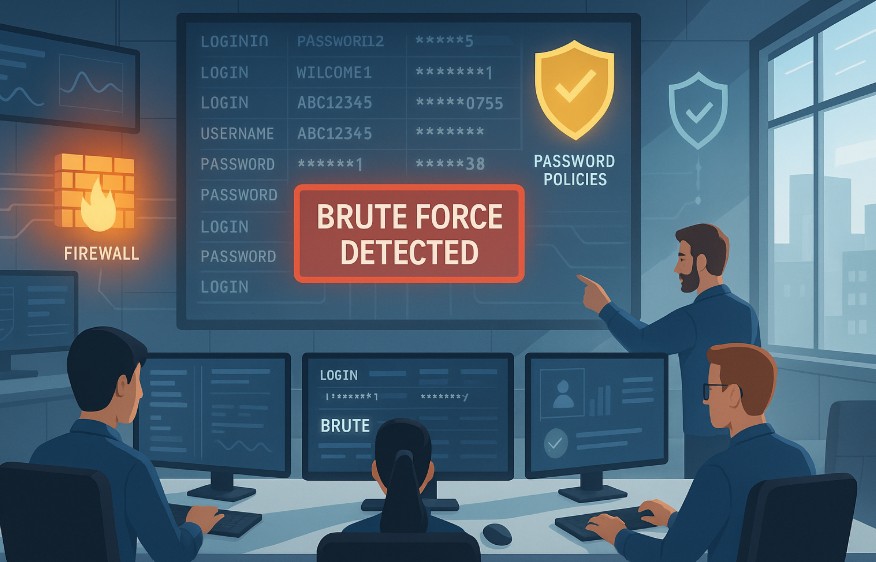
Have you ever thought about how hackers manage to break into secured systems without exploiting complex software bugs? Surprisingly, they often don’t need to. One of the simplest and most effective techniques in a hacker’s toolkit is the brute force attack.
Despite the increasing sophistication of cyber security tools, brute force attacks remain a persistent and damaging threat to individuals and businesses alike. This article explores what brute force attacks are, how they work, the tools and strategies attackers use, and what you can do to defend against them.
By the end, you’ll have a full understanding of why these attacks still matter and how to prevent them from affecting your organisation or personal data.
What is a Brute Force Attack and Why Does It Still Matter?

A brute force attack is a type of cyber attack where the attacker tries numerous combinations of usernames and passwords in an attempt to gain unauthorised access to a system. It’s called “brute force” because the attacker is using raw computing power to guess the correct credentials through persistent trial and error.
This type of attack doesn’t rely on exploiting code or software vulnerabilities. Instead, it targets a system’s weakest link user credentials. Brute force attacks are effective because users often select weak or predictable passwords, and in many cases, reuse those passwords across multiple platforms.
According to industry reports, 5% of all confirmed security breaches are the result of brute force attacks. Automation has made them even more dangerous. Bots can attempt thousands of password combinations every second, overwhelming login systems and penetrating accounts before security teams even realise there’s an issue.
So, while the technique may seem outdated compared to modern malware and phishing, brute force attacks remain highly relevant due to their simplicity, scalability, and effectiveness, especially against systems with poor password hygiene and limited authentication layers.
How Do Brute Force Attacks Work in Practice?
At its core, a brute force attack involves attempting various combinations of usernames and passwords until the correct one is found. Traditionally, attackers may have guessed credentials manually. Today, the overwhelming majority of brute force attacks are performed using automated bots or scripts that try numerous combinations at high speed.
These attacks typically follow a predictable pattern, bots attempt logins using lists of commonly used passwords or actual credentials obtained from previous data breaches. The bots report back to the attacker when access is successfully gained.
Some attackers also look for valid session IDs to bypass login forms altogether. These session identifiers, when exposed or predictable, can grant unauthorised access without needing to guess a password.
A single brute force attack can lead to a wide range of consequences, from data theft to malware injection, denial-of-service events, and even full-scale network breaches. What’s more, the simplicity of this approach makes it extremely appealing for attackers.
Why Do Attackers Use Brute Force Methods?

The motivations for carrying out brute force attacks vary, but the method’s simplicity and success rate make it particularly attractive to cybercriminals. Hackers often exploit the human tendency to create simple, guessable passwords. Research shows that 83% of users create passwords that are either too short or lack complexity. Moreover, 53% of people use the same password across multiple platforms.
In many cases, the information used in a brute force attack is gathered from the public domain. For example, a hacker who knows a user supports a particular sports team and was born in 1990 may try passwords such as “Bears1990” or “FanChicago90”.
Brute force attacks are also financially motivated. According to IBM’s Cyber Security Intelligence Index, 71% of breaches are driven by financial gains.
Once access is gained, attackers can:
- Steal sensitive company data
- Access financial systems or customer information
- Install ransomware
- Sell login credentials on the dark web
Because brute force doesn’t require vulnerability in the system, just a weak password, it’s a universal threat that can target any user or organisation.
What Are the Common Types of Brute Force Attacks?
Brute force attacks vary in sophistication and approach. Understanding the key types is crucial for identifying and preventing them effectively.
- Simple Brute Force Attack: This is the most basic form. The attacker tries every possible password combination manually or using a script. While time-consuming, it can be effective if the password is short or lacks complexity.
- Dictionary Attack: In this method, the attacker uses a precompiled list of potential passwords (called a “dictionary”) based on common phrases, patterns, or leaked data. The attack then tests these against the target system.
- Hybrid Attack: A combination of dictionary and brute force, this method starts with known words or phrases and then tries various permutations and combinations. For example, using “Password” and then testing “Password1”, “Password123”, or “Passw0rd”.
- Reverse Brute Force Attack: Here, the attacker starts with a known password, typically a commonly used one like “123456”, and tests it across numerous usernames. This type of attack is particularly effective when attackers already have some leaked credential data.
- Credential Stuffing: In credential stuffing, attackers use known combinations of usernames and passwords (often from past breaches) and attempt to access multiple systems. The high success rate is due to users reusing the same login credentials across different services.
- Rainbow Table Attack: This attack involves using precomputed tables that map encrypted password hashes back to their plain text equivalents. It’s effective against systems that use weak or outdated hashing algorithms.
- Password Spraying: Rather than attacking one account with many passwords, attackers try a few common passwords across many accounts. This reduces the chance of detection and account lockout.
How Do Online and Offline Brute Force Attacks Differ?

Brute force attacks can also be classified based on their method of execution: online or offline.
| Type | Description |
| Online Attack | The attacker targets live systems or applications over the internet. These are often slow due to system lockout policies or rate-limiting. |
| Offline Attack | The attacker has already obtained password hashes and works offline to decrypt them using software. These are faster and harder to detect. |
Offline attacks are particularly dangerous as they do not interact with the system during the cracking process, bypassing many security monitoring tools.
What Tools and Hardware Are Used in Brute Force Attacks?
Modern brute force attacks rely heavily on automation and high-performance hardware. Some of the most widely used tools include:
- John the Ripper: Open-source software used for password cracking and vulnerability testing.
- Aircrack-ng: Designed specifically for Wi-Fi security testing using dictionary and brute force methods.
- Hashcat: An Advanced password recovery tool that supports dictionary, brute force, and hybrid attacks on password hashes.
These tools often require significant processing power, especially when dealing with complex passwords. Attackers frequently use GPUs (Graphics Processing Units) for this purpose.
For example, the NVIDIA RTX 3090 can make password guesses hundreds of times faster than a standard CPU, dramatically reducing the time required to break passwords.
What Real-World Examples Show the Impact of Brute Force Attacks?

Brute force attacks have affected some of the world’s biggest companies and millions of users. Two notable examples include:
Dunkin’ Donuts (2015)
Hackers used stolen credentials and brute force scripts to breach 19,715 customer loyalty accounts, stealing reward balances. The attack cost the company $650,000 in fines and damages and led to a complete overhaul of its customer authentication systems.
Alibaba (2016)
A group of hackers utilised a list of 99 million breached credentials to attempt brute force logins on Alibaba’s e-commerce platform. They successfully accessed over 20.6 million accounts, leveraging weak passwords and password reuse. These cases highlight how brute force attacks are not just theoretical risks, they are real threats with real consequences.
How Do Brute Force Attacks Compare to Other Cyber Attacks?
Understanding how brute force attacks differ from or relate to other types of attacks helps in designing comprehensive defence strategies.
| Attack Type | Key Focus |
| Brute Force | Repeated attempts to guess credentials |
| Dictionary Attack | Uses predefined password lists |
| Password Spraying | Applies one password to multiple users |
| DoS (Denial-of-Service) | Overloads systems to cause disruption |
| DDoS | Distributed DoS attack using multiple sources |
| Credential Stuffing | Reuses leaked credentials across systems |
While some of these techniques may overlap, brute force remains a uniquely versatile and widely used method.
What Are the Best Strategies to Prevent Brute Force Attacks?
The most effective defence against brute force attacks is reducing the attacker’s chance of success. This means improving password complexity, enforcing authentication policies, and adopting modern security frameworks.
Start by requiring strong passwords:
- Use 12+ characters
- Combine letters, numbers, and special characters
- Avoid names, dates, or common words
- Ensure every account has a unique password
Additionally, enable multi-factor authentication (MFA) across all systems. This single step can block over 99.9% of automated attacks.
Other recommended practices include:
- Enforcing account lockout policies
- Using CAPTCHA to stop bots
- Deploying rate limiting to slow repeated login attempts
- Encouraging or enforcing regular password changes
- Considering passwordless authentication, such as biometrics or hardware tokens
Implementing a Zero Trust Architecture, where every access request is verified and authenticated, adds another layer of protection.
How Does StrongDM Improve Defence Against Brute Force Attacks?
StrongDM provides a Zero Trust Privileged Access Management (PAM) platform that simplifies secure access management.
Key features include:
- Centralised authentication integrated with identity providers
- Enforced password complexity and MFA
- Secure password storage (hashed and never in plain text)
- Automatic account lockouts after repeated failed attempts
- Compatibility with tools like Duo Security for enhanced security enforcement
By consolidating control and visibility, StrongDM helps organisations reduce risk and detect suspicious behaviour before it becomes a breach.
FAQs
Can brute force attacks bypass two-factor authentication?
Not typically. Multi-factor authentication creates a secondary barrier that renders brute force attacks ineffective even if the password is compromised.
Is a dictionary attack the same as a brute force attack?
Not exactly. A dictionary attack is a specific type of brute force attack that uses a list of known passwords rather than testing every possible combination.
Why is password reuse dangerous?
If one system is compromised, reused credentials can be used to access other accounts in credential stuffing attacks.
Can brute force attacks be detected in real time?
Yes. Systems with proper monitoring and intrusion detection can flag high volumes of failed login attempts and take automated actions.
What’s the most secure type of authentication?
Biometric or hardware-based authentication methods, like tokens or fingerprint scans, are among the most secure.
How many login attempts indicate a brute force attack?
Dozens or hundreds of failed attempts from a single IP address within minutes is a common sign.
Is brute force still relevant with today’s modern cyber tools?
Yes, especially when passwords are weak or reused, and when systems lack multi-factor authentication.